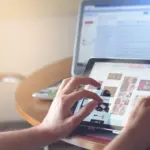What is corporate design?
What is it, and why is it so important?
Self-expression is part of everyday life for most Internet users today, but it is also indispensable for companies. How a person wants to present themselves and how they are actually perceived can be completely different. It’s the same with companies. For this reason, a plan is drawn up specifically for a company’s personality as to how the desired image can be conveyed to the outside world.
The personality of a company—the corporate identity—has three effective instruments of self-representation: corporate behaviour, corporate communication, and corporate design. These together form the so-called corporate image of a company. The three building blocks of a corporate image go hand in hand. The corporate design includes the visual level, i.e., the development of a uniform appearance for the company.
But why is a good corporate design necessary?
The corporate design is the first thing that potential customers notice, since image elements are decoded faster in the human brain than text elements. A professional and appealing corporate design immediately creates a positive image of a company. It is important here that a design grid be developed that can be transferred to all media. A continuous red thread is crucial for a good corporate design. Interested parties should be able to recognise directly to which company a business card or flyer belongs without having to think for themselves. The logo is, of course, particularly important for this because the logo is the heart of the corporate design on which everything else is based.
What are the components of a corporate design?
A corporate design is based on a creative concept that was developed for the company. The concept consists of a typographical approach, a colour concept, design elements, and design rules on how to place them.
Where relevant, this concept can be applied to printed matter, audiovisual media, product design, industrial design, architecture, and fashion. Therefore, business stationery, as well as brochures, posters, flyers, etc., must be kept in the corporate design, but the website, commercials, or your own products should continue to spin the common thread. The corporate image not only has to be maintained externally; the employees also have an image of the company.
The design of the company building, the design of the vehicle fleet, and the company clothing must also be part of the corporate design of the company. At the heart of it all, which can and must also be applied to more specialised media such as vehicles or clothing, is the company’s logo.
Why is the logo so important?
The logo is the face of a company; it should represent the brand behind it and be recognisable quickly. There are different ways to create a logo; it can consist of a word mark and a figurative mark, or just use one of them. In the best possible case, a customer can tell which company it is from the figurative mark alone, which is why some large companies only use one figurative mark, the so-called signet.
However, since only a very few companies can do this, people like to work with word marks as well as letters, numbers, or a combination of a word and a figurative mark. The latter has high memorability due to the combination of image and text. At best, the logo of the company shows what it offers or in which industry it is active. In this way, the viewer can decide directly whether the company is of interest to him.
Our conclusion
Every company needs a face—an external appearance that interested parties can use to determine whether the company is of interest to them. First of all, viewers perceive the corporate design; before they even begin to read a word, their brain recognises the image elements and assigns them. If you don’t want the viewer to jump off immediately, an interesting, structured design is needed to turn a prospect into a customer. If the company presents itself particularly positively on a visual level, the viewer automatically develops a positive association with the company’s services or products.




